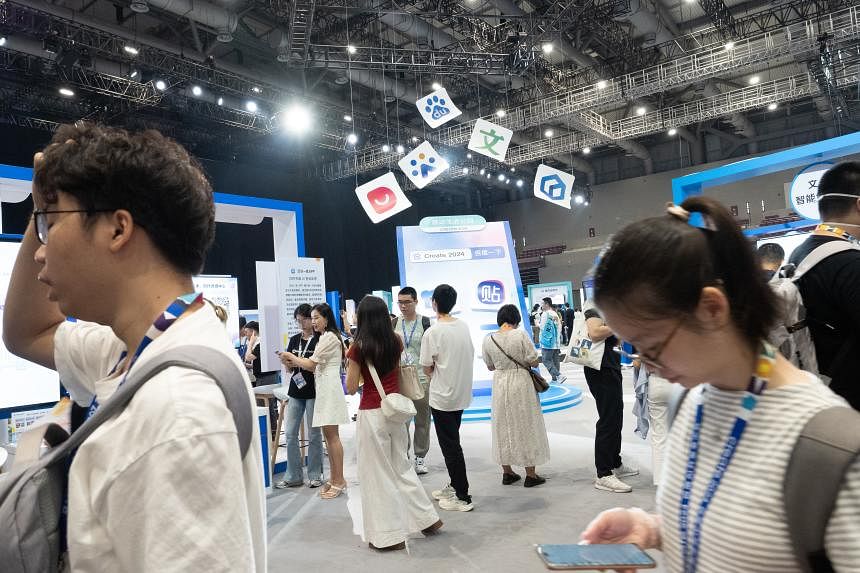BEIJING – About a year ago, a group of China-based Tencent employees came together because of a common aspiration to enable everyone – even those without knowledge of computer programming – to create their own role-playing games.
The result of that shared ambition was the founding of the start-up RPGGO, launched in February 2024, which provides a free platform for game creators with little to no coding experience, as well as players.
“We aim to democratise the creation of games,” said Mr Zhang Lei, the start-up’s founder.
The group of developers left gaming giant Tencent to work on the RPGGO platform, which is powered by generative artificial intelligence (AI).
The technology gained global attention via the public release in late 2022 of ChatGPT – the free-to-use chatbot developed by the US-based OpenAI and which assists users in tasks such as writing emails, essays and computer code.
Already, “thousands” of game creators have used the platform, said Mr Zhang, whose 15 employees are based in China, the United States and the United Kingdom.
Games developed so far include one that allows a player to solve a murder mystery in the year 1903 in London.
On the back of a global boom in generative AI, enterprises and developers in China have surged ahead in finding new and practical ways to apply the technology. These include tools for writing financial reports, grading high school essays and generating presentation slides.
Other applications allow the creation of product images and 30-second video clips as promotional materials, with commercialisation potential a key driver of these uses, especially in e-commerce.
Behind generative AI apps are AI models, the core engines that do the intelligent work, analysing huge amounts of data to recognise patterns and make predictions. For example, a photo editing app might use one AI model to enhance image quality and another to apply artistic filters.
In China, generative AI models released to the public have to adhere to “socialist core values”, a set of values such as harmony, civility and prosperity that is encouraged by the Communist Party of China.
The internet regulator, the Cyberspace Administration of China, disclosed on April 2 that 117 generative AI models have been approved for public use.
These range from powerful ones by major tech firms, such as Alibaba’s Tongyi Qianwen which can perform tasks from summarising meeting notes to drafting business proposals, to those with more specific uses, such as TAL Education Group’s MathGPT, which can solve mathematics problems, and gaming firm Shanghai Giant Network Technology’s GiantGPT for game development.
With the growth in models, applications have proliferated, aided by lowered barriers to entry.
One of these is tech giant Baidu’s suite of software tools that helps people with little or no coding knowledge to make apps with generative AI, an upgrade of which was unveiled at the company’s annual developer conference in Shenzhen on April 16.
“AI is stirring a creative revolution; developing apps in the future will be as simple as shooting a video,” said Baidu’s chief executive Robin Li at the conference.
This was as he was giving a live demonstration of creating an app for organising tours to Singapore, including buying tickets for attractions and booking hotels.
“Everyone is a developer,” he declared at the forum.
Baidu, known more for its search engine, has in recent years doubled down on its early investments in AI, with its Ernie Bot 4.0, unveiled in October 2023, seen as among the top Chinese competitors to ChatGPT and Google’s Gemini.
Over at e-commerce giant JD.com, founder Richard Liu caused a stir when his lifelike, AI-powered digital avatar appeared on a live stream on April 16 to hawk goods on his platform for the first time.
More than 20 million people viewed the publicity stunt in an hour.
“AI applications are undeniably a core strength of China’s AI ecosystem,” said Ms Esme Pau, chief executive of EmergentX Insights, a digital assets and AI advisory firm, and a former tech analyst focused on China and Asia.
This comes as China and its tech companies integrate AI into most aspects of its economy, from digital entertainment to commerce, Ms Pau said, adding that the country’s large population provides fertile ground for significant monetisation of AI applications.
The key strength in China’s AI ecosystem is policy support from Beijing, which manifests in the form of funding, strategic plans, infrastructure and ecosystem development, she said.
China also has a vast population that enables AI applications to be developed, tested and deployed at scale, allowing for rapid iteration and innovation.
On the flip side, the primary challenge in China’s AI sector could be constraints on the supply of AI chips, potentially limiting the speed of AI innovation and development, said Ms Pau.
The US has led an effort since late 2022 to restrict the export to China of leading-edge computer chips and the technology and equipment to make them, as the tech competition between the two major powers grows.
According to the AI Index Report 2024 by the Stanford Institute for Human-Centred AI released on April 15, the US led in the sector with 61 notable machine learning models in 2023, followed by China with 15, and France with eight. These are models regarded as particularly influential, and used as an indicator of frontier AI research.
Taking a different view is industry observer Rui Ma, who believes that both innovation, represented by large models, and commercialisation, represented by applications, must co-exist and typically work in a virtuous circle.
“Large models, if not useful, could have gone the way of many other inventions that don’t have any impact, and, in fact, most of the innovations today are driven by real or perceived commercial needs and less by researchers in academia, as typically happens when a tech becomes more widely adopted,” she said.
Ms Rui, who is the founder of the Tech Buzz China podcast and newsletter, cited Chinese venture capitalist Allen Zhu, managing director of GSR Ventures, which invests in early-stage tech firms globally, including in China and the US.
Mr Zhu, known for his early investment into ride-hailing firm Didi Chuxing in 2012, disclosed in a March 2024 interview that he did not invest in any Chinese company focused on large language models (LLMs) in 2023, as there is no profit involved in developing them without application scenarios.
China is ahead in certain areas, like video ads for e-commerce, said Ms Rui, adding that robotics could be another area where China will lead, with its widespread use there. “This shows that Chinese investors are looking for specific opportunities that can make money now, like video ads for online shopping, instead of just trying to lead in AI technology.”
Mr Li Ruochong, a master’s student in AI at the Hong Kong University of Science and Technology (Guangzhou) who is working on a project that can generate bonsai designs based on a supplied poem, said that lowering the barriers to entry is a boon to programmers.
“As programmers, we are not worried about losing our jobs. In fact, having more use cases means that the size of the market has also expanded,” he said.
Asked about China’s competition with the US, he said: “The US has a greater focus on developing algorithms, and they indeed have the first-mover advantage, for instance, when ChatGPT was first released and took everyone by surprise.”
Mr Li added: “But once we get to know the paradigm and how the technological process works, we can achieve rapid iteration. That’s our advantage.”
For now, the hype seems far from dying down.
Mr Zhang of RPGGO said creators on his start-up’s platform include web novel writers, anime virtual YouTubers, and fan artists. Players are mostly ACG (anime, comics and games) and Dungeons & Dragons fans, as well as Roblox players, he said, referring to the popular online multiplayer game.
“Quite a number of them are high school students, which says that the younger generation is more adapted to this new form of AI-native product.”


